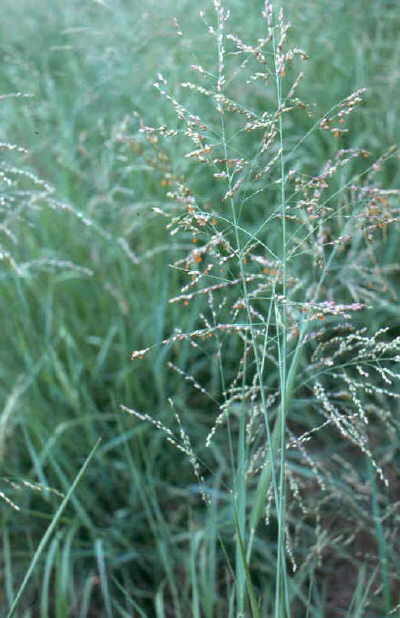Liver Poisoning: Alsike Clover, Kleingrass (Panicum sp.), and
Pyrrolizidine Containing Plants in the Horse
by Robert N. Oglesby DVM
Introduction
Introduction
»
Symptoms Overview
»
Alsike Clover
»
Kleingrass (Panicum sp.)
»
Pyrrolizidine Poisoning Overview
»
Tansy Ragwort, Groundsel, Senecio sp.
»
Crotalaria (rattlebox or rattlepod)
»
Amsinckia
»
Other Pyrrolizidine Containing Plants
»
Treatment and Prognosis
»
More Info & Discussions
There are several plants or weeds that commonly infest horse pasture that are known to be toxic to the liver. The medical term for this is hepatotoxic. Often the toxin is pyrrolizidine but in some cases the toxin is not known. Some of the more common plants that are known toxic include:
- Pyrrolizidine Containing Plants
Pyrrolizidine alkaloids (PAs) are potent liver toxins that have been identified in over 6,000 plants throughout the world. About half of the identified PAs are toxic and several cause cancer though this is not reported in horses. PA-containing plants are the most common poisonous plants that affect livestock. - Crotalaria (rattlebox or rattlepod)
- Heliotropium
- Amsinckia (fiddleneck)
- Senecio (dozens of common names including ragwort and groundsel)
- Unknown Toxin
- Alsike Clover (Trifolium)
- Kleingrass (Panicum)
This article discusses the plants which are hepatotoxic, their characteristics, how to identify them, and how to control them. Symptoms, treatment, and prognosis are briefly covered but covered in great detail in the article on Liver Disease and Failure,
...more..
Symptoms of Plant Hepatoxicity
Introduction
»
Symptoms Overview
»
Alsike Clover
»
Kleingrass (Panicum sp.)
»
Pyrrolizidine Poisoning Overview
»
Tansy Ragwort, Groundsel, Senecio sp.
»
Crotalaria (rattlebox or rattlepod)
»
Amsinckia
»
Other Pyrrolizidine Containing Plants
»
Treatment and Prognosis
»
More Info & Discussions
All of the plants covered in this article are hepatotoxic so the symptoms seen are common to liver dysfunction. However symptoms can be remarkably different depending on the specific type of effected cells, the rate of degeneration, and the severity of the liver damage,. For instance hoses with acute liver failure from a large dose of tansy ragwirt are more likely to have dementia (depression, aggression, seizures, coma) and incoordination as their initial and predominant sign or if the dose large enough, simply found dead.
Horses with exposure to alsike clover are more likely to have chronic liver damage and suffer weight loss and photosensitivity as the first symptoms. Gastric impaction and bilateral laryngeal paralysis are two of many complications that may be seen with equine hepatic failure. Horses with liver disease that is most pronounced in the biliary system responsible for processing old worn out red blood cells are often more jaundiced, have photosensitivity, and less likely to have CNS signs.
Because of the differential toxicity of these plants some of them typically cause chronic symptoms of photosensitivity while others more often cause acute symptoms. But it is important to remember the whole range of possibilities as ingesting small amount of the very toxic plants may cause chronic symptoms and large doses of the less toxic plants may cause more acute symptoms.
Another important difference is the effect of acute and chronic poisoning on the level of liver enzymes. Most of the plants cause death of the hepatocytes or biliary cells. As they die they release specific enzymes into the blood that are easily tested for. So while the presence of elevated levels of these enzymes is indicative of possible liver problems, chronic poisoning or advance cirrohis of the liver may present with normal or very mild elevations, despite serious disease. Below are general guidelines of what happens most commonly with exposure to a particular plant. For more on the secific symptoms and diagnosis of liver disease see
Liver Disease and Failure in the Horse
Alsike clover
Introduction
»
Symptoms Overview
»
Alsike Clover
»
Kleingrass (Panicum sp.)
»
Pyrrolizidine Poisoning Overview
»
Tansy Ragwort, Groundsel, Senecio sp.
»
Crotalaria (rattlebox or rattlepod)
»
Amsinckia
»
Other Pyrrolizidine Containing Plants
»
Treatment and Prognosis
»
More Info & Discussions
[wcm_restrict]
Alsike clover (Trifolium) appears to be toxic under some conditions but the toxic principle remains unknown. Alsike clover is commonly included as a part of a prepackaged pasture seed mix and well adapted to cool climates and poorly drained clay soils. Alsike clover is an inferior forage compared to other commonly used legumes and should be avoided in pastures used by horses. There are two syndromes associated with horses grazing rapidly growing alsike clover: secondary photosensitization and alsike clover poisoning.
Syndromes and Sign Associated with Alsike Clover
Secondary photosensitization
Secondary photosensitization produces skin lesions similar to sunburn and the nonpigmented portions of the skin are most effected. The causative agent within alsike clover that causes photosensitization has not been identified. Removal of thehorses from the offending plant generally results in rapid resolution of clinical signs. For specific treatment of sunburn see:
Irritated Skin.
Alsike clover poisoning
Alsike clover poisoning can occur after exposure of several weeks or greater than a year. It appears that the amount of time to note symptoms is dependent upon the amount of the clover being consumed as pasture or hay. Symptoms include jaundice, neurological disturbances, anorexia and loss of body condition. Current evidence is not real strong to incriminate alsike clover as the causative agent of alsike clover poisoning. Evidence from alsike clover poisoning cases in Canada suggest that an endophytic (within plant) bacteria of the genus Capnocytophaga may have an important part in the expression of the disease.
Identification
Before making a diagnosis of alsike clover related disease it is important to differentiate alsike from red and white clovers which do not cause liver disease.
Control of Alsike Clover
Clovers of all types are sensitive to broad leaf herbicides applied during growth. Control without herbicides is possible by mowing when tall and before seeding out. Spring fertilization with nitrogen at 100lbs N to the acre will suppress growth.
Kleingrass (Panicum sp.)
Introduction
»
Symptoms Overview
»
Alsike Clover
»
Kleingrass (Panicum dichotomiflorum)
»
Pyrrolizidine Poisoning Overview
»
Tansy Ragwort, Groundsel, Senecio sp.
»
Crotalaria (rattlebox or rattlepod)
»
Amsinckia
»
Other Pyrrolizidine Containing Plants
»
Treatment and Prognosis
»
More Info & Discussions
Kleingrass (Panicum sp.) is good quality forage for cattle, but can cause liver damage in horses. A warm season grass not native to the US it was imported in the 50's because of its drought tolerance and now can be found through out the Southern US. Green growth after moisture or grazing is reported to be more toxic than old or dormant growth. The toxin survives drying and curing so hay can be toxic.
Symptoms
Clinical signs are usually those of chronic poisoning and include icterus, photosensitivity, and weight loss. With continued exposure hepatic encephalopathy may develop and is a bad prognostic sign. Photosensitivity may develop around the coronary band and cause lameness. Affected animals should be removed from the kleingrass source, fed good-quality hay, and protected from sunlight. The prognosis from mildly effected horses immediately removed and treated is good.
Control
A perennial monocot, kleingrass cannot be controlled with mowing or herbicides without killing the other grasses present. If the pasture is extensively contaminated it will require spraying with herbidcides and reestablishment of the pasture.
Pyrrolizidine Poisoning Overview
Introduction
»
Symptoms Overview
»
Alsike Clover
»
Kleingrass (Panicum sp.)
»
Pyrrolizidine Poisoning Overview
»
Tansy Ragwort, Groundsel, Senecio sp.
»
Crotalaria (rattlebox or rattlepod)
»
Amsinckia
»
Other Pyrrolizidine Containing Plants
»
Treatment and Prognosis
»
More Info & Discussions
Crotalaria (rattlebox or rattlepod), Heliotropium, Amsinckia (fiddleneck), Senecio (dozens of common names including ragwort and groundsel) are known causes of pyrrolizidine poisoning in horses. Identification of these plants is covered below. The toxic principle are many different forms of pyrrolizidine alkaloids (PA's). PA's are metabolized to pyrroles in the liver which then bind to the DNA, impairing cell division and causing cell death. Histologically hepatocytomegaly, necrosis, and when advanced cirrohis of the liver can be seen.
These plants are tough and bitter so under normal conditions avoided by horses but may be eaten when other forms of forage are sparse. In particular overgrazing and drought conditions make poisoning far more likely. The toxin survives cutting and curing so may be present in in hay, silage, or pellets. Seeds are often the most toxic part of the plant and toxicity has occured when harvested with grains.
Young, growing animals are more sensitive to poisoning. Pyrrolizidine alkaloids are excreted in milk, urine and will cross the placenta so can adversely effect the fetus and nursing foal. They are considered to be carcinogens, and a potential public health risk.
Species Affected
Cattle and horses most susceptible. Sheep and swine require higher doses. Chronic PA poisoning occurs worldwide, leading to extensive losses.
Clinical Signs
The symptoms are primarily those of acute liver failure. Symptoms common in horses are yawning, drowsiness, staggering, aimless walking, colic, cribbing and death. 'Sleepy staggers' and 'walking disease'. With chronic poisoning there may be first a secondary photosensitization - subcutaneous edema, dry, scaly muzzle. Hemolysis is a reported sequela, causing kidney damage and hematuria
...more.
Treatment
Because these plants are very toxic usually severe damage is done quickly and treatment unsuccessful but there are exceptions. Removal from further access to plant, and aggressive treatment for liver disease may help
...more.
Tansy Ragwort, Groundsel and other Senecio sp.
Introduction
»
Symptoms Overview
»
Alsike Clover
»
Kleingrass (Panicum sp.)
»
Pyrrolizidine Poisoning Overview
»
Tansy Ragwort, Groundsel, Senecio sp.
»
Crotalaria (rattlebox or rattlepod)
»
Amsinckia
»
Other Pyrrolizidine Containing Plants
»
Treatment and Prognosis
»
More Info & Discussions
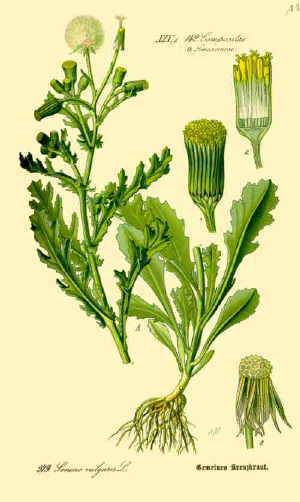 |
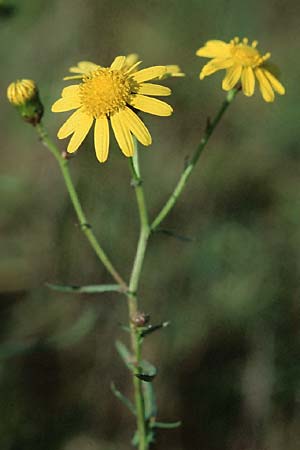 |
|
There are many different species of Senecio that vary widely in their appearance and toxicity. In general the flowes are yellow with the above appearance. |
Tansy ragwort, Groundsel, and possibly other Senecio species are bienniel herb with basal growth the first year. In second year, grows tall, erect (0.5-1 m), and flowers. Leaves dissected, palmate with narrow segmentation, whorled, bracts form a cup under the head. Numerous yellow flowers clustered at the top.
Toxicity
Tansy ragwort, Groundsel, and other Senecio species contain a number of pyrrzolizidine toxins. Acute intake of 1% to 2% of a horse's body weight will result in acute death. In the chronic form ingestion of small amounts over a months period will result in clinical signs beginning a week to five months later. The flowers are considered most toxic and the dried plant is still toxic when it contaminates hay. Poisoning occurs most often from ingestion of contaminated hay or grazing when no other forage available.
Distribution
Senecio species have worldwide distribution along roadsides, poor pastures, waste places and anywhere there is poor quality, poorly drained soils.
Control
Senecio is hard to control with broadleaf herbicides and even glycophosphate. Promoting healthy pasture and two years of mowing the flowers before seeds form will control this weed.
Crotalaria sp. (rattlebox or rattlepod)
Introduction
»
Symptoms Overview
»
Alsike Clover
»
Kleingrass (Panicum sp.)
»
Pyrrolizidine Poisoning Overview
»
Tansy Ragwort, Groundsel, Senecio sp.
»
Crotalaria (rattlebox or rattlepod)
»
Amsinckia
»
Other Pyrrolizidine Containing Plants
»
Treatment and Prognosis
»
More Info & Discussions
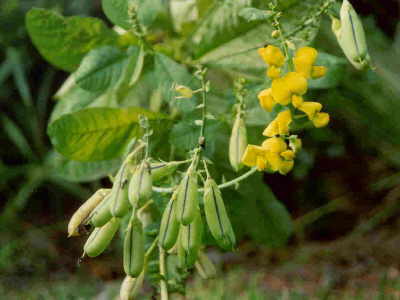 |
|
Crotolaria has worldwide distribution. There are many species of Crotolaria that are toxic and they very widely in their appearance. Usually the flowers and seed pods are typical however. Notice the pea-like appearance of the flowers and the shape of the seed pods. When dry the seeds rattle in the pod hence the common name of rattelbox. |
The plant may appear following land clearing where trees are removed and the soil disturbed. The total amount of ingested plant material that will result in serious harm may be equivalent to 1.5 percent to 3 percent of the animal's body weight. This can be ingested in small amounts over several days or weeks.The seeds and foliage contain pyrrolizidine alkaloids that are readily absorbed from the digestive tract. Liver enzymes convert the alkaloids into toxic pyrroles that poison liver and lung cells in horses. Cattle, swine and poultry are also susceptible, with acute or chronic damage to the liver being the major effect. Sheep and goats may be more resistant to these alkaloids.
Toxicity
Crotalaria poisoning may be acute or chronic. The acute form appears within a few days after a substantial amount of the plant is consumed. Affected horses have liver failure and are suddenly very ill and may exhibit head pressing or a sleepy appearance or become agitated and dangerous to handle. Death may occur within hours after signs first develop. The chronic form of crotalaria poisoning is more common, with progressive fibrosis of the liver leading to emaciation and death. Signs of illness, including weight loss, a sleepy appearance, frequent yawning, aimless and continuous walking, may appear months after the plant was last consumed. The onset of these signs coincides with liver failure and may occur weeks after the initial exposure.
Amsinckia: Fiddleneck or Tarweed
Introduction
»
Symptoms Overview
»
Alsike Clover
»
Kleingrass (Panicum sp.)
»
Pyrrolizidine Poisoning Overview
»
Tansy Ragwort, Groundsel, Senecio sp.
»
Crotalaria (rattlebox or rattlepod)
»
Amsinckia
»
Other Pyrrolizidine Containing Plants
»
Treatment and Prognosis
»
More Info & Discussions
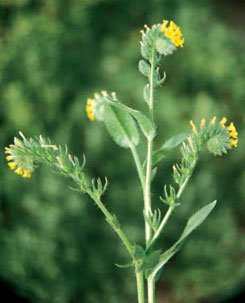 |
|
Amsickia (fiddleneck, tarweed, burr weed, fireweed and buckthorn) is an erect, sparsely branched annual weed that grows up to 3 ft (1 m) tall and is covered with numerous, fine white hairs. Leaves are hairy, lanceolate, and alternate. The perfect five-parted, small, orange to yellow flowers are born terminally on a characteristic fiddleneck-shaped raceme, with the flowers all inserted on one side of the axis. Mature fruits separate into two to four blackridged nutlets. |
The plants appear in late winter and early spring. The seeds are the most toxic parts of these plants and fortunately the mature plants are unpalatable to most horses. Most instances of poisoning occur when mature amsinckia species are bailed in early cuttings of hay or when contaminated grain was threshed for horses. Some poisonings have occurred when horses were pastured on wheat stubble in contaminated fields.
Toxicity
Poisoning can be either acute or chronic. Affected horses have been known to walk aimlessly for miles, running into objects in their path rather than go around them, pressing their heads into solid objects and occasionally becoming frenzied when they cannot continue. Oftentimes death results from the horse getting hopelessly entangled in a fence or literally walking over the edge of a cliff or ravine. Other behavioral abnormalities include recklessness, charging, lack of coordination, circling, staggering, "dragging" of the hind limbs, which have been described as the "sleepy staggers". The horse may also appear listless, hang its head and acting sluggish or depressed. Signs of colic may be present, which may include straining, diarrhea and rectal prolapse. Small foul smelling ulcers may appear in the mouth.
The chronic patient will become a poor keeper, show yellow membranes around the eyes and mouth, produce a rough coat and eventually become anemic and die.
Other Pyrrolizidine Containing Plants
Introduction
»
Symptoms Overview
»
Alsike Clover
»
Kleingrass (Panicum sp.)
»
Pyrrolizidine Poisoning Overview
»
Tansy Ragwort, Groundsel, Senecio sp.
»
Crotalaria (rattlebox or rattlepod)
»
Amsinckia
»
Other Pyrrolizidine Containing Plants
»
Treatment and Prognosis
»
More Info & Discussions
Heliotrope
Heliotropium is a genus of flowering plants in the borage family, Boraginaceae. There are 250 to 300 species in this genus, which are commonly known as heliotropes and have worldwide distribution and some species reported as a source of PA poisoning of horses. The name "heliotrope" derives from the fact that these plants turn their leaves to the sun. The old English name is "turnsole". Several heliotropes are popular garden plants, most notably Garden Heliotrope (H. arborescens). The sap of heliotrope flowers, namely of European Heliotrope (H. europaeum), was used as a food coloring in Middle Ages and Early Modern French cuisine. Common heliotrope is grown in Southern Europe as an ingredient for perfume. |
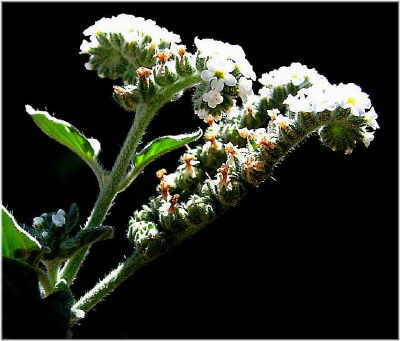
European Heliotrope (H. europaeum)
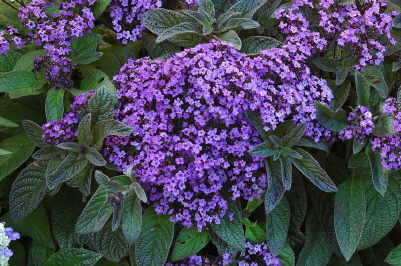
Garden Heliotrope (H. arborescens) |
|
Cynoglossum
There are many species in the plant genus Cynoglossum They are coarse-appearing, small-flowered plants of the family Boraginaceae. Cynoglossum officinale, the common hound's-tongue, is a native of Asia, Africa, and Europe. It has been introduced into North America, and there have been multiple reports of horses poisned by this plant.More Information on
J Am Vet Med Assoc. 1984 Sep 15;185(6):647-50.
Cynoglossum officinale (hound's-tongue)--a cause of pyrrolizidine alkaloid poisoning in horses.
Knight AP, Kimberling CV, Stermitz FR, Roby MR.
The death of 10 horses was attributed to feeding dried grass hay containing hound's-tongue, Cynoglossum officinale. Affected horses developed weight loss, icterus, photosensitization, and hepatic encephalopathy. Histologic examination of the liver of 3 of the horses revealed megalocytosis, biliary hyperplasia, and fibrosis characteristic of pyrrolizidine alkaloid poisoning. Hound's-tongue was found to contain large quantities (0.6% to 2.1%, dry matter basis) of toxic pyrrolizidine alkaloids, which, when fed to a pony for 20 days, caused liver fibrosis and biliary hyperplasia. |
The toxicity of the many other species is not known but should be suspect until proved differently. Cynoglossum virginianum, known as Wild comfrey, is a common plant from New York to Florida. Cynoglossum boreale occurs in the northern United States as far west as Minnesota and in Canada. Cynoglossum amabile, known as Chinese Forget-me-not and Chinese Hound's Tongue, originally a wildflower from Southwest China, is now found in Europe and North America. |
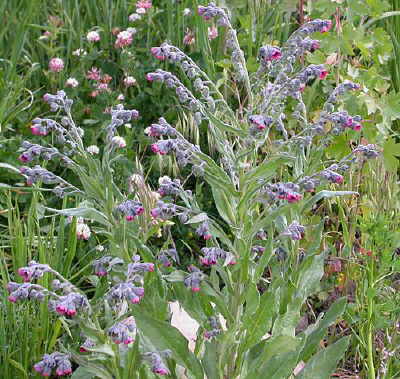
Cynoglossum officinale
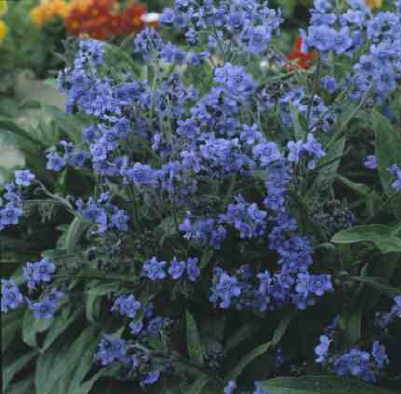
Cynoglossum amabile |
|
Echium
Echium plantagineum (Purple Viper's Bugloss) is a species of Echium, native to western and southern Europe (from southern England south to Iberia and east to the Crimea), northern Africa, and southwestern Asia (east to Georgia). It has also been introduced to Australia and is an invasive plant, killing horses who accidentally consume it.
It is an annual or biennial plant growing to 20-60 cm tall, with rough, hairy, lanceolate leaves up to 14 cm long. The flowers are purple, 15-20 mm long, with all the stamens protruding, and borne on a branched spike. Patterson's Curse is now a dominant pasture weed through much of New South Wales, the Australian Capital Territory, Victoria, South Australia and Tasmania and also infests native grasslands, heathlands and woodlands. The plants contain pyrrolizidine alkaloids and, when eaten in large quantities, cause reduced livestock weight or even (in severe cases) death. Paterson's Curse can kill horses and irritate the udders of dairy cows and the skin of humans. After the 2003 Canberra bushfires over 40 horses were officially put down after eating the weed. |
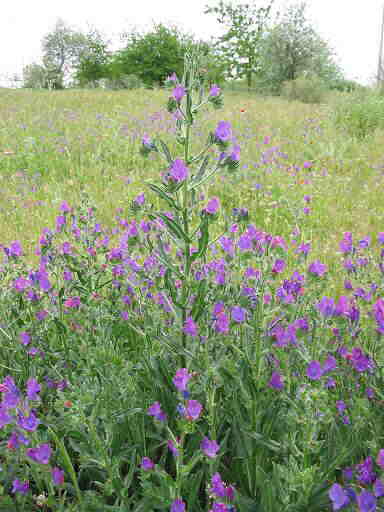
 |
Treatment and Prognosis
Introduction
»
Symptoms Overview
»
Alsike Clover
»
Kleingrass (Panicum sp.)
»
Pyrrolizidine Poisoning Overview
»
Tansy Ragwort, Groundsel, Senecio sp.
»
Crotalaria (rattlebox or rattlepod)
»
Amsinckia
»
Other Pyrrolizidine Containing Plants
»
Treatment and Prognosis
»
More Info & Discussions
Treatment
Specific treatment for sunburn and liver disease are covered in detail elsewhere, links are provided below.
Sunburn
The first step of treatment is to remove the horse from access to the offending plant and protect him from sunlight until the blood has a chance to clear the toxins. Depending on the severity of liver disease this may take several weeks to several months. Following the levels of toxins that have built up in the blood, like bilirubin, can help decide when it is safe to allow the horse back out into the daylight. Treatment for the skin disease would be the same for sunburn
...more.
Hepatoencephalopathy
If hepatoencephalopathy is a concern, a low high quality protein (high branch chain / low aromatic amino acid ratio) diet should be fed and neomycin or lactuloseb should be given per os (via syringe) to decrease enteric ammonia production. Feeds with small amounts of carbohydrates and branch chain amino acid should be given every 2-4 hours. For a more complete description of treatment see,
Liver Disease and Failure.
Prognosis
Treatment is often successful for many of the above as long as fibrosis is not prominent however extensive damage and fibrosis is often present with hepatotoxic plants so a guarded prognosis is indicated. Consider these facts when evaluating prognosis:
- Signs of liver failure do not occur until 60 to 70% of the liver is dysfunctional
- There are two types of injuries to the liver: initially the hepatocytes become dysfunctional but not dead but with continued insult die and fibrosis (liver cirrohsis) takes their place.
-
Lesions present in effected and asymptomatic animals may progress over several months
The fact that your horse is showing signs of failure indicates the liver is effected widely so the question needed for a prognosis will depend on how badly the liver is damaged. This is best answered by a liver biopsy but this is not an easy test and even somewhat dangerous since horses with liver failure often have impaired clotting ability. Photosensitization is one of the earliest changes and when the only symptoms is a favorable prognostic sign. Neurological disease on the other hand occurs when even larger amounts of the iiver are effected and when serious damage to the hepatocytes has occurred and so should be considered a sign for a guarded to poor prognosis.
For More Information on this Topic:
Introduction
»
Symptoms Overview
»
Alsike Clover
»
Kleingrass (Panicum sp.)
»
Pyrrolizidine Poisoning Overview
»
Tansy Ragwort, Groundsel, Senecio sp.
»
Crotalaria (rattlebox or rattlepod)
»
Amsinckia
»
Other Pyrrolizidine Containing Plants
»
Treatment and Prognosis
»
More Info & Discussions
Search the National Library of Medicine for all the summaries on this topic. Just push the button the search fields have been already filled in:
[/wcm_restrict][wcm_nonmember] [text-blocks id="article-ender-join"][/wcm_nonmember]
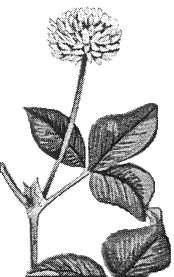
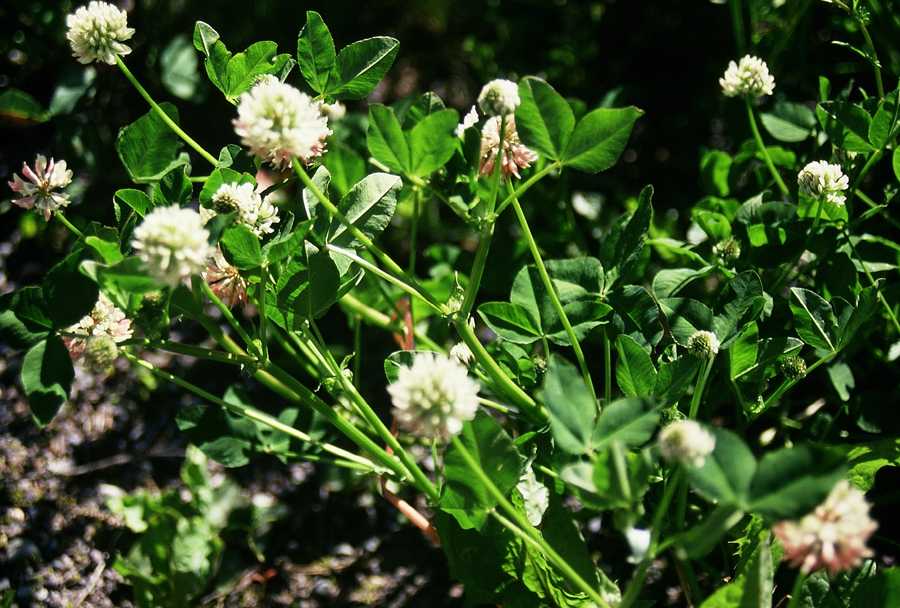 Alsike Clover has white to slightly pink flowers. Note the lack of light colored chevrons on the leaves which you see on red and white clover.
Alsike Clover has white to slightly pink flowers. Note the lack of light colored chevrons on the leaves which you see on red and white clover.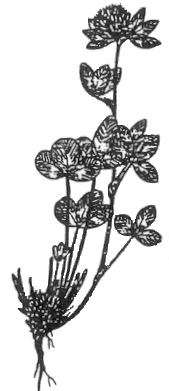
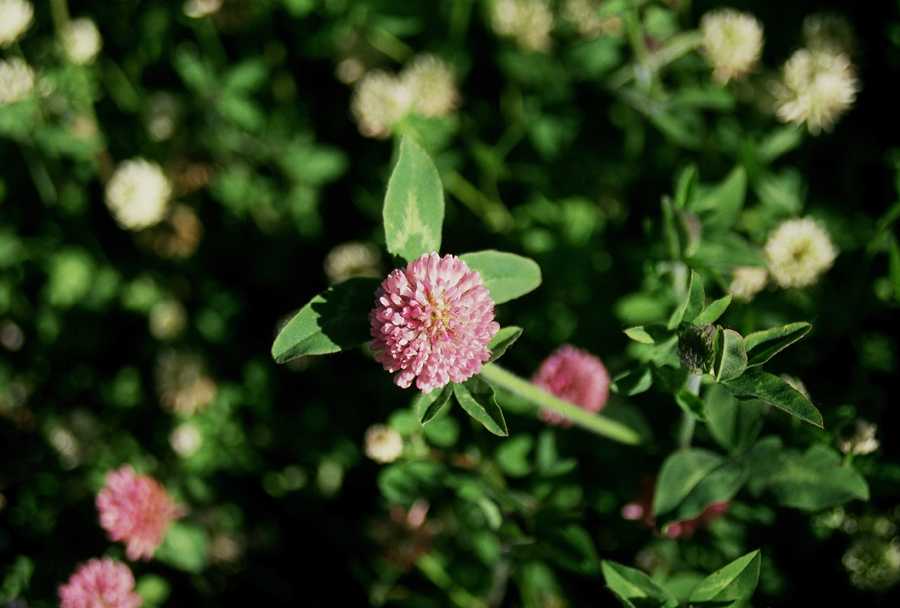 Red clover has distinctly red to purple flowers and lighter chevrons on the leaves.
Red clover has distinctly red to purple flowers and lighter chevrons on the leaves.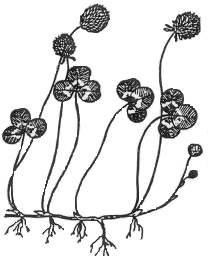
 White clover has white flowers with no leaves on the flowers stems and lighter chevrons on the leaves.
White clover has white flowers with no leaves on the flowers stems and lighter chevrons on the leaves.